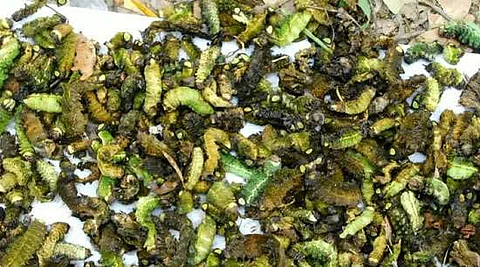
- Home
- Live Blog
- Breaking News
- Top Headlines
- Cities
- NE News
- Sentinel Media
- Sports
- Education
- Jobs

A CORRESPONDENT
LAKHIMPUR: May 4: Muga silk and related industry is potent enough to establish a unique identity of Assam in the world. Despite having such potential, the industry is under tremendous threat at present in the whirlpool of changing time and alleged negligence shown by the State Government. Alarming death of thousands of Muga silk worms has nipped the dreams of a group of Muga cultivators in Dhakuakhona Sub-division of Lakhimpur district in the bud during the last few days. The reason behind the unexpected phenomenon is considered to be the non-judicious use of the insecticides and pesticides in the small tea gardens near the Muga silk worm rearing arenas of the sub division.
It is here to be noted that the North Eastern Region of the nation is enriched with sericulture bio-diversity and the place is believed to be the origin of Antheraea species in the world. Muga silk is produced by a worm of Antheraea Assama species which is confined only to North-eastern India. The intensive cultivation of this worm is found in the Brahmaputra valley of the State. Lakhimpur district in general and Dhakuakhona Sub-division in particular is the traditional Muga growing area in the world.
As per report, there are 10,000 traditional Muga cultivators in the sub-division who are actively involved in this culture covering an area about 1600 hectares of land with Muga food plants. In most cases these cultivators are not integrated regarding Muga production; but they have conserved the culture and respective bio-resources through interlinking it with their crop cycle since time immemorial. They are unknowingly following the principle of sustainable agriculture with this endeavor. It provides them a way to earn their bread and thus production of Muga silk has assumed the status of an industrial system. Apart from generation of income and employment, Muga cultivation can be utilized for environmental up-gradate too by expanding the Muga growing areas with Muga food plantation like Machilus odoratissima, locally known as Chom Gash.
Under such circumstances, just four days ago, the unexpected death of thousands of matured Muga silk worms, locally known as Jethua Muga and Bor Muga, has caused heartrending grief to around one hundred Muga cultivators who jointly reared these worms at the Muga chomanis (Chom tree plantation area for Muga rearing) located at the Dhenukhona-Batomari-Kothalpora area under Ghilamora Police Station of the sub-division covering over one hundred bighas of land.
The reason behind the disaster is considered to be the spraying of pesticides and insecticides a day ago in the small tea gardens nearby the chomanis. It is known that these cultivators collected these muga seeds from border area of Nagaland, Garo Hills and Goalpara district spending around rupees twelve lakh and they expected to earn more than a crore through Muga silk production. The phenomenon led the victim Muga cultivators to file an FIR at Ghilamora Police Station against small scale tea planters Duleswar Gogoi, Pranab Gogoi, Bhodreswar Gogoi, Mina Gogoi, Hemanta Gogoi, Ruhiteswar Gogoi, to name a few, seeking justice and compensation. While a case has been registered, the probe launched by Ghilamora Police has hit the roadblock as regards the cause of the death of the silk worms.
Meanwhile, the affected Muga cultivators are seeking the interventions of Lakhimpur DC and the concerned department to help them in coping with the disastrous situation.